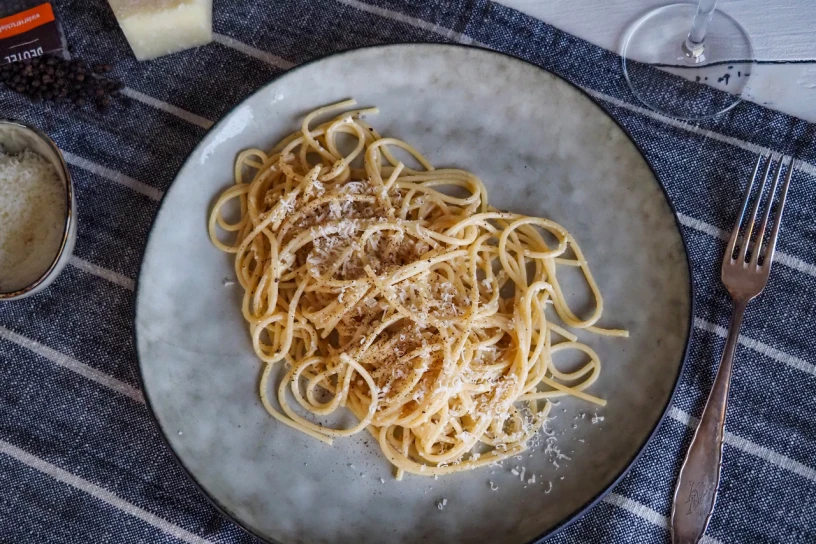How To Make Authentic Cacio e Pepe

Transport yourself to Italy with a plate of Cacio e Pepe. Only three ingredients and a bit of attention how to prepare the dish are needed.
Cacio e pepe translates to cheese and pepper, which essentially sums up what you get on your plate, plus obviously pasta. It is one of the four historic Roman pasta dishes including Carbonara, Amatriciana, and Gricia. All four use only few ingredients but are unbelievably delicious.
The humble Caio e pepe used to be popular with Roman shepherds. They only had to carry a minimum of only dried ingredients, and thus would keep well over a long time, and could easily prepare the dish anywhere when travelling with their herds.
For an authentic Cacio e Pepe, pasta (usually spaghetti or the slightly thicker bucatini), black pepper, and Pecorino Romano come together for one of the simplest but hugely delicious and most popular classic Roman pasta dishes ever.
While it sounds simple, with only three ingredients needed, to prepare a plate of authentic Cacio e Pepe worthy of the name, you need to pay attention to the preparation process.
Most importantly, while you might find recipes adding olive oil, butter, or cream, the authentic dish does not include any (never!). Nor does it include salt.
Likewise important, the dish calls for Pecorino Romano. Again, some recipes replace Pecorino Romano with Parmigiano Reggiano, or will tell you, you can use either. This is not true. If you want to make an authentic Cacio e Pepe, your only choice can be Pecorino Romano. Why? Well, both Pecorino and Parmigiano are hard cheeses, but there are significant differences. Differently to Parmigiano, which is made from cow’s milk, Pecorino is made from sheep’s milk. It has a shorter aging period (five to eight months) compared to Parmigiano and it is slightly saltier and has a stronger flavour. Therefore, it is the Pecorino Romano that will give the Cacio e Pepe its unique flavour.
How to make the original 3 ingredients Cacio e Pepe
To prepare the original Cacio e Pepe pasta dish, you only need three ingredients. But to obtain the creamy consistency of the cheese sauce that makes this simple dish so outstandingly delicious you need to pay close attention to the preparation process.
The secret to make authentic Roman Cacio e Pepe lies in preparing a perfect Cacio (cheese) sauce using only finely grated Pecorino Romano and pasta water.
Follow the instructions below to make this popular Italian weeknight dish like it’s made in its native Rome.
Serves 4
500 g spaghetti or bucatini
1.5 teaspoons whole black peppercorns
120 g finely grated Pecorino Romano
In a large skillet, toast the whole peppercorns over medium heat, shaking the pan occasionally. Fry until the peppercorns are fragrant and start to crack, for around 3 to 4 minutes. Set aside to let cool. Coarsely crush the peppercorns, using either a mortar and pestle or a heavy skillet.
Fill a large saucepan just under halfway with water and bring to boil over medium heat. Most importantly, do not add any salt to the water. Add the pasta and cook just short of the required time according to directions, usually 7 to 9 minutes.
Return the peppercorns to the skillet. Just before the pasta is cooked al dente, transfer 120 ml of the cooking water to the skillet. Bring to simmer over medium heat then add the pasta (keep the remaining cooking water). Continue to cook until the water is almost completely evaporated, tossing the pasta frequently. This should take around 3 to 4 minutes and will release the starch into the pan.
In the meantime, place the freshly grated Pecorino Romano in a medium-sized bowl. Start drizzling some of the retained cooking water (1 to 2 tablespoons) over the cheese. Mash with a fork to combine. Continue to drizzle more cooking water over the cheese until obtaining a soft but still solid cream.
Take the skillet with the pasta from the heat and let cool for around one minute. Add the cheese mixture to the pasta and stir in quickly using a fork.
If the cheese seems to thick, not clinging to the pasta, drizzle with a little bit of the cooking water. The cheese paste should turn into a creamy sauce fully coating the pasta.
Distribute the pasta over four plates, drizzle with the remaining sauce in the skillet and more black pepper if desired.